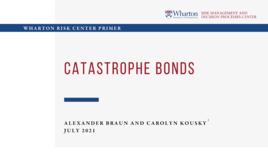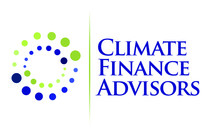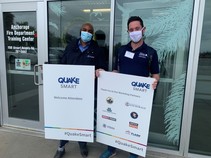|
August 2021
Resilient Nation Partnership Network and NASA Hosting
“Alliances for Climate Action” Forum
On August 6, 2021, the Intergovernmental Panel on Climate Change (IPCC) finalized the first part of the Sixth Assessment Report, Climate Change 2021: The Physical Science Basis. The report paints a dire picture for the future of our planet and states, “It is unequivocal that human influence has warmed the atmosphere, ocean and land… The scale of recent changes across the climate system as a whole and the present state of many aspects of the climate system are unprecedented over many centuries to many thousands of years.”
Adapting to, and mitigating, the impacts of climate change cannot be addressed by any one individual, community, or organization alone. The IPCC identified this as well, stating “Forging partnerships among all involved with producing, exploring and distilling climate data into climate information is at the center of creating stakeholder-relevant information. These partnerships… can serve the varied needs of all who would fold climate information into their decision processes. All of these partnerships are vital for arriving at climate information that responds to physical and cultural diversity.”
Now, more than ever, partnerships are critical to becoming a more resilient nation. Actions we take now will make a difference as we adapt to, and mitigate, the impacts of climate change. The Resilient Nation Partnership Network is committed to taking collaborative action and is proud to announce the Sixth Annual Partnership Forum, "Alliances for Climate Action", in partnership with FEMA and the National Aeronautics and Space Administration (NASA). The virtual series will occur every Wednesday from 12-2 p.m. ET. Each week we’ll host a different discussion on how to advance climate action at the national, state, and local levels.
- October 6 – "Our Future Vision"
- October 13 – "When Climate Moves Communities"
- October 20 – "Stories That Inspire"
- October 27 – "Financing Climate Action"
The four-week event will host opportunities for partners to engage with industry peers and identify future opportunities and collaborations to advance climate action within our work.

|
Upcoming Events
Funding Opportunities
|
Partner News

Updates from ARISE-US
Free Critical Asset Management System
ARISE-US volunteers are developing a free tool to enable towns and cities to inventory their critical assets and track the relationships between them, so that cascading failures can be identified in advance, planned for and, as funding allows, mitigated. The tool will be GIS-based, built on open source components and offer both cloud and stand-alone options. We need towns and cities to become pilot users to help us test the tool and make sure it meets needs.
If you would like your town or city to participate, please contact Peter Williams at ARISE-US - rpwilliams1958@gmail.com.
Web Symposium - "Wildfire Risk Reduction—Connecting the Dots"
Wildfire risk is growing and changing, driven by expanding settlement boundaries and climate change, and exacerbated by historical forest management practices. This trend is stressing existing approaches to managing and insuring wildfire risk. ARISE-US is hosting a free web symposium on “Wildfire Risk Reduction—Connecting the Dots.” It will feature public and private sector experts and will discuss integrated solutions to the challenges of wildfire risk. The symposium will be valuable for insurers, governments, engineers, risk managers, land/building owners, catastrophe modelers, financial services and community organizations.
Speakers include Dave Jones, Insurance Commissioner Emeritus, California (keynote); plus experts from Willis Towers Watson, FM Global, Geospatial Insurance Consortium, Wildfire Planning International, BGC Engineering Inc, U.S. Forest Service, and the Center for Insurance Policy and Research.
The symposium will take place on Tuesday Sept 21, from 1 to 3 p.m. ET. Mark your calendars, and send a request for a formal invitation to rpwilliams1958@gmail.com.
|
Natural Hazards Center and the National Academies of Sciences, Engineering, and Medicine: Addressing Disaster Vulnerability Among Homeless Populations During COVID-19
Drawing from research on homelessness, the pandemic, and hazards and disasters, this publication discusses alternative shelter facilities for homeless populations during a disaster; how to navigate service reductions; and guidance for supporting populations experiencing homelessness in the aftermath of disasters.
|
Updated from the Union of Concerned Scientists
|
The Inequities of Keeping Cool in Urban Heat Islands
As climate change worsens extreme heat, the risk of harm to vulnerable populations will increase. Resources are needed to reduce these risks, and climate change mitigation through reduction of heat-trapping emissions is needed to slow the worsening of extreme heat.
|
Wildfire Smoke in Your Area? Six Things to Know for Staying Safe
Millions of people who don’t regularly experience smoke are exposed to hazardous conditions as wildfire smoke is blown further east across the U.S. Here are the essential things to know so you can stay safe when skies are smoky.
|
A Framework for a People-Centered Clean Energy Transition
UCS and an advisory committee of external experts examine an approach to deep decarbonization that centers people—who use energy and who bear a disproportionate burden of the harms caused by fossil fuels—and recognizes the need for systemic changes. UCS and an advisory committee of external experts examine an approach to deep decarbonization that centers people—who use energy and who bear a disproportionate burden of the harms caused by fossil fuels—and recognizes the need for systemic changes.
|
|
|
|
|
The Nature Conservancy: New Guide Helps Communities Tap Into FEMA Hazard Mitigation Funds
The Nature Conservancy recently worked with AECOM, an engineering firm, to produce a comprehensive guide titled “Promoting Nature-Based Hazard Mitigation through FEMA Mitigation Grants.”
Learn more here
|
|
Join us to hear stories of how climate change is affecting faith communities, how those communities are building resilience, and how the federal government must invest in climate-ready infrastructure.
Register here
|
|
|

Updates from Meso Safety
More Than One Way of Receiving A Warning
"MesoSafety" wrote a very well-thought-out article on having more than one way of receiving a warning during a disaster.
Preparing Children for Disasters
"MesoSafety" wrote an article for the month of August focused on preparing children for disasters. We have seen an incredibly positive response as a result.
|
Environmental Defense Fund—Blog: 4 strategies for policymakers to get more natural infrastructure in the ground, fast
Investments in coastal natural infrastructure in the U.S. have increased at a rate of approximately 7% annually, with an average of $593 million in investments per year. A new paper outlines these trends and strategies for getting more projects built.
Updates from the Wharton Risk Center
Conversations About Climate Change and Insurance

The Wharton Risk Center is hosting a series of conversations examining different topics at the intersection of insurance and climate change throughout the second half of 2021. We hope you will join us to discuss these issues, which range from the insurability of climate perils and the impacts on housing markets, to how insurers can promote decarbonization of the economy.
|

New Resources: Original Paper and New Primer on Catastrophe Bonds
The Wharton Risk Center just released a new primer on catastrophe bonds and published a paper on microinsurance.
New Paper: Can Parametric Microinsurance Improve the Financial Resilience of Low-Income Households in the United States? by Kousky, C., H. Wiley, and L. Shabman (2021)
New Primer on Catastrophe Bonds: Catastrophe Bond Primer by Alexander Braun and Carolyn Kousky
The first catastrophe bonds were issued in the mid-1990s and the market has been steadily growing since that time. This primer explains the general mechanics of catastrophe bonds, provides examples of their use, and outlines future opportunities for the market.
|
Updates from the Climate Finance Advisors

Five Steps to Incorporate Insurance for Resilience Planning
This examines steps policy makers can take to leverage the expertise on insurance and insurance products, both within government and from the insurance industry, for climate risk assessment and management.
Resilient Transportation Presentation
This summary presentation outlines best practices, strategies, and frameworks from a recent webinar on integrating climate resilience within transportation systems and road networks. Panelists discussed approaches to integrating physical climate risk into infrastructure investment and planning for transportation.
|

Economic Resilience and Recovery Planning Following COVID-19
With all this federal funding, do our local governments have the capacity and capabilities to manage, let alone apply for all this funding? Let's take a look, focusing on USEDA as an example.
|

FEMA Launches Full Application of the National Risk Index with More Customization and Reporting and Data Updates
FEMA announced the full application launch of the National Risk Index, an online resource that visually identifies traits of the communities most at risk from natural hazards. This online mapping application provides a holistic view of community risk by providing baseline relative risk scores. It measures a community’s risk for 18 natural hazards, in addition to resilience, social vulnerability and expected annual loss.
|

Alaska DHSEM Hosts QuakeSmart 3.0 Debut
Resilience in the face of seismic risk presents challenges in many communities, but perhaps nowhere greater than Alaska, which averages 1,000 earthquakes each month.
That’s why Alaska DHSEM Director Bryan Fisher brings the business community together to ensure continuity, mitigation, and preparedness plans create resilience. The FEMA/FLASH QuakeSmart workshop in Anchorage on July 28 drew 35 organizations, including electric and gas utilities, telecommunications, railroad, the Department of Defense, and more.
Ironically, later the same evening, a powerful M8.2 earthquake triggered a tsunami warning, evacuations in coastal communities, and a stark reminder to get and remain QuakeSmart.
|
Digital Divide, Data and Resilience
Georgetown faculty member Monica Sanders released a short policy article, "The Confluence of Poverty, the Digital Divide and Disaster Vulnerability on Children: Baltimore and Puerto Rico as Case Studies." The article's expanded peer review included emergency managers and disaster scientists. It highlights why poverty and digital access are important considerations for successful resilience building and mitigation planning. It is published here: https://bit.ly/2Vt8uGs.
Earlier this year, the professor questioned the use of big data and artificial intelligence to make government programs more efficient. When dealing with vulnerable groups, it carries the same bias and mistrust issues as other uses of the technologies. Some solutions and research concepts can be found here: https://www.hsaj.org/articles/17234. Next, her team will be looking at the concept of how an "Internet for Everyone" can become resilient green infrastructure while promoting resilience and social cohesion. She welcomes comments and ideas from the community and can be reached at ms4532@georgetown.edu.
Launch of the Build Change Guide to Resilient Housing
Please join us on September 2 from 2 to 3 p.m. ET for the launch event for the Build Change Guide to Resilient Housing: An Essential Handbook for Governments and Practitioners, which captures key lessons learned from nearly 20 years of implementation experience. The guide provides a roadmap for governments, funders and practitioners around the world with the tools they need to carry out successful resilient housing programs at scale.
|
FEMA: "My Rain Garden" Coloring Book
FEMA developed the “My Rain Garden” coloring book to teach children ages 4 to 7 about how rain gardens can make their homes safer.
This 10-page book includes a short narrative about a young girl discovering how a rain garden can make her yard safer, a glossary of terms to help expand vocabulary, and activities that can be done with an adult.
"My Rain Garden" is part of the “Safer Communities” coloring book series that teaches children about mitigation solutions in a fun and easily understandable way.
|
EESI Climate Resilience and National Security Panel
The Environmental and Energy Study Institute (EESI) and the House and Senate Renewable Energy and Energy Efficiency (REEE) Caucuses hosted the Virtual Congressional Clean Energy Expo at the end of July. You can check out recordings of the entire expo, including a panel on “What does climate change mean for national security and resilience?” here.
|
|
|
|